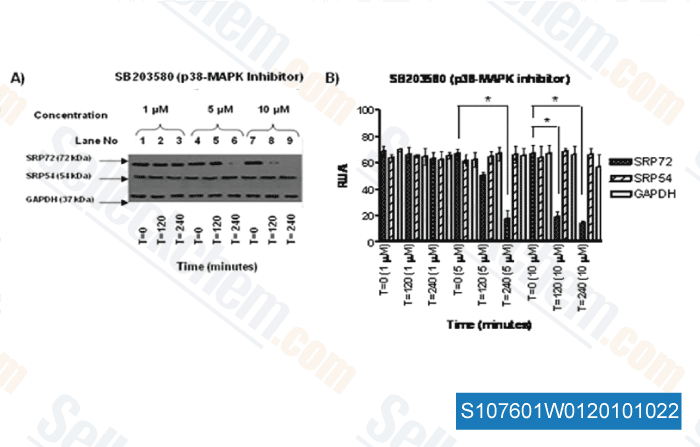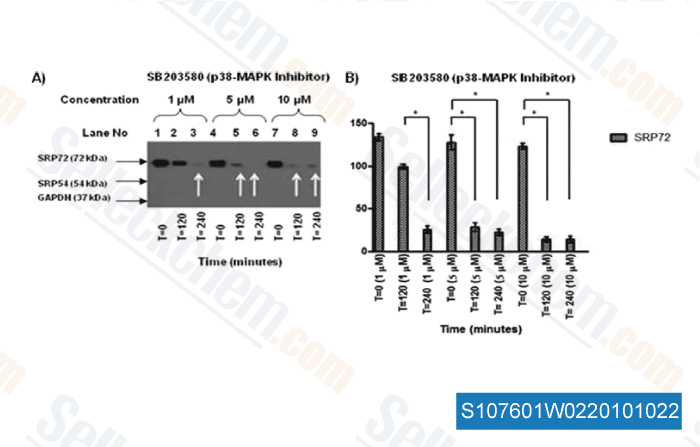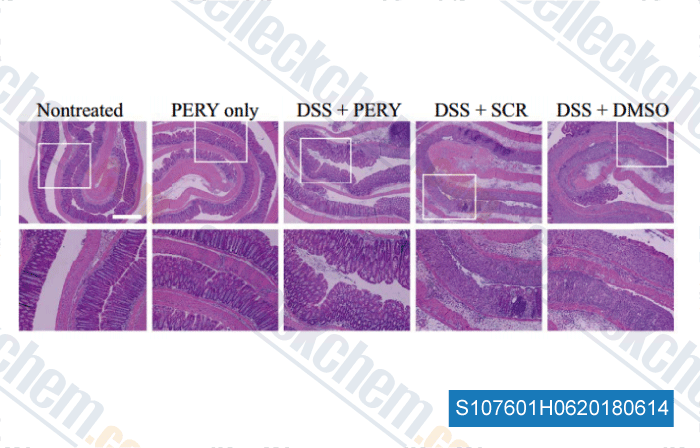|
Toll Free: (877) 796-6397 -- USA and Canada only -- |
Fax: +1-832-582-8590 Orders: +1-832-582-8158 |
Tech Support: +1-832-582-8158 Ext:3 Please provide your Order Number in the email. |
Technical Data
| Formula | C21H16FN3OS |
|||
| Molecular Weight | 377.43 | CAS No. | 152121-47-6 | |
| Solubility (25°C)* | In vitro | DMSO | 75 mg/mL (198.71 mM) | |
| Water | Insoluble | |||
| Ethanol | Insoluble | |||
|
* <1 mg/ml means slightly soluble or insoluble. * Please note that Selleck tests the solubility of all compounds in-house, and the actual solubility may differ slightly from published values. This is normal and is due to slight batch-to-batch variations. * Room temperature shipping (Stability testing shows this product can be shipped without any cooling measures.) |
||||
Preparing Stock Solutions
Biological Activity
| Description | Adezmapimod (SB203580, RWJ 64809, PB 203580) is a p38 MAPK inhibitor with IC50 of 0.3-0.5 μM in THP-1 cells, 10-fold less sensitive to SAPK3(106T) and SAPK4(106T) and blocks PKB phosphorylation with IC50 of 3-5 μM. SB203580 induces mitophagy and autophagy. | ||||
|---|---|---|---|---|---|
| Targets |
|
||||
| In vitro | SB203580 inhibits the IL-2-induced proliferation of primary human T cells, murine CT6 T cells, or BAF F7 B cells with an IC50 of 3–5 μm. SB203580 also inhibits IL-2-induced p70S6 kinase activation, although the concentration required is slightly higher with an IC50 above 10 μm. SB203580 also inhibits the activity of PDK1 in a dose-dependent manner with an IC50 in the 3–10 μm range. [1] SB203580 inhibits p38-MAPK stimulation of MAPKAPK2 with an IC50 of approximately 0.07 μM, whereas inhibits total SAPK/JNK activity with an IC50 of 3–10 μM. SB203580 at higher concentrations activates the ERK pathway, which subsequently enhances NF-κB transcriptional activity. [2] SB203580 induces autophagy in human hepatocellular carcinoma (HCC) cells. [3] | ||||
| In vivo | SB203580 protects pig myocardium against ischemic injury in an in vivo model. [4]SB203580 is effective to prevent and treat the disease in MRL/lpr mice model of Systemic lupus erythematosus (SLE). [5] | ||||
| Features | First reported p38 inhibitor. |
Protocol (from reference)
| Kinase Assay: |
|
|---|---|
| Cell Assay: |
|
| Animal Study: |
|
References
Customer Product Validation

-
Data from [J Biol Chem, 2010, 285, 32824-32833]

-
Data from [J Biol Chem, 2010, 285, 32824–32833]

-
Data from [J Biol Chem, 2010, 285, 32824–32833]

-
Data from [Data independently produced by , , Science, 2018, 11(525), doi: 10.1126/scisignal.aao3428]
Selleck's Adezmapimod (SB203580) has been cited by 936 publications
| Phosphorylation of human glioma-associated oncogene 1 on Ser937 regulates Sonic Hedgehog signaling in medulloblastoma [ Nat Commun, 2024, 15(1):987] | PubMed: 38307877 |
| Kisspeptin-10 binding to Gpr54 in osteoclasts prevents bone loss by activating Dusp18-mediated dephosphorylation of Src [ Nat Commun, 2024, 15(1):1300] | PubMed: 38346942 |
| Bactericidal/permeability-increasing protein instructs dendritic cells to elicit Th22 cell response [ Cell Rep, 2024, 43(3):113929] | PubMed: 38457343 |
| Ammonia stress-induced heat shock factor 1 enhances white spot syndrome virus infection by targeting the interferon-like system in shrimp [ mBio, 2024, e0313623.] | PubMed: 38358252 |
| Securinine inhibits the tumor growth of human bladder cancer cells by suppressing Wnt/β-catenin signaling pathway and activating p38 and JNK signaling pathways [ Biochem Pharmacol, 2024, 223:116125] | PubMed: 38484850 |
| ERK1/2-CEBPB Axis-Regulated hBD1 Enhances Anti-Tuberculosis Capacity in Alveolar Type II Epithelial Cells [ Int J Mol Sci, 2024, 25(4)2408] | PubMed: 38397085 |
| PCSK9 increases vulnerability of carotid plaque by promoting mitochondrial dysfunction and apoptosis of vascular smooth muscle cells [ CNS Neurosci Ther, 2024, 30(2):e14640] | PubMed: 38402551 |
| FGF18 alleviates sepsis-induced acute lung injury by inhibiting the NF-κB pathway [ Respir Res, 2024, 25(1):108] | PubMed: 38419044 |
| Licochalcone A induces mitochondria-dependent apoptosis and interacts with venetoclax in acute myeloid leukemia [ Eur J Pharmacol, 2024, 968:176418] | PubMed: 38350590 |
| Antioxidant and Antimelanogenic Activities of Lactobacillus kunkeei NCHBL-003 Isolated from Honeybees [ Microorganisms, 2024, 12(1)188] | PubMed: 38258014 |
RETURN POLICY
Selleck Chemical’s Unconditional Return Policy ensures a smooth online shopping experience for our customers. If you are in any way unsatisfied with your purchase, you may return any item(s) within 7 days of receiving it. In the event of product quality issues, either protocol related or product related problems, you may return any item(s) within 365 days from the original purchase date. Please follow the instructions below when returning products.
SHIPPING AND STORAGE
Selleck products are transported at room temperature. If you receive the product at room temperature, please rest assured, the Selleck Quality Inspection Department has conducted experiments to verify that the normal temperature placement of one month will not affect the biological activity of powder products. After collecting, please store the product according to the requirements described in the datasheet. Most Selleck products are stable under the recommended conditions.
NOT FOR HUMAN, VETERINARY DIAGNOSTIC OR THERAPEUTIC USE.
